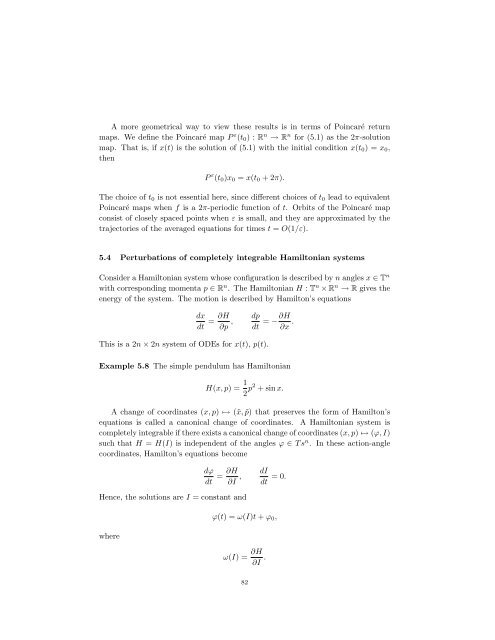Asymptotic Analysis and Singular Perturbation Theory
Asymptotic Analysis and Singular Perturbation Theory
Asymptotic Analysis and Singular Perturbation Theory
You also want an ePaper? Increase the reach of your titles
YUMPU automatically turns print PDFs into web optimized ePapers that Google loves.
A more geometrical way to view these results is in terms of Poincaré return<br />
maps. We define the Poincaré map P ε (t0) : R n → R n for (5.1) as the 2π-solution<br />
map. That is, if x(t) is the solution of (5.1) with the initial condition x(t0) = x0,<br />
then<br />
P ε (t0)x0 = x(t0 + 2π).<br />
The choice of t0 is not essential here, since different choices of t0 lead to equivalent<br />
Poincaré maps when f is a 2π-periodic function of t. Orbits of the Poincaré map<br />
consist of closely spaced points when ε is small, <strong>and</strong> they are approximated by the<br />
trajectories of the averaged equations for times t = O(1/ε).<br />
5.4 <strong>Perturbation</strong>s of completely integrable Hamiltonian systems<br />
Consider a Hamiltonian system whose configuration is described by n angles x ∈ T n<br />
with corresponding momenta p ∈ R n . The Hamiltonian H : T n × R n → R gives the<br />
energy of the system. The motion is described by Hamilton’s equations<br />
dx<br />
dt<br />
= ∂H<br />
∂p ,<br />
dp<br />
dt<br />
This is a 2n × 2n system of ODEs for x(t), p(t).<br />
= −∂H<br />
∂x .<br />
Example 5.8 The simple pendulum has Hamiltonian<br />
H(x, p) = 1<br />
2 p2 + sin x.<br />
A change of coordinates (x, p) ↦→ (˜x, ˜p) that preserves the form of Hamilton’s<br />
equations is called a canonical change of coordinates. A Hamiltonian system is<br />
completely integrable if there exists a canonical change of coordinates (x, p) ↦→ (ϕ, I)<br />
such that H = H(I) is independent of the angles ϕ ∈ T s n . In these action-angle<br />
coordinates, Hamilton’s equations become<br />
dϕ<br />
dt<br />
= ∂H<br />
∂I ,<br />
Hence, the solutions are I = constant <strong>and</strong><br />
where<br />
dI<br />
dt<br />
ϕ(t) = ω(I)t + ϕ0,<br />
ω(I) = ∂H<br />
∂I .<br />
82<br />
= 0.
















